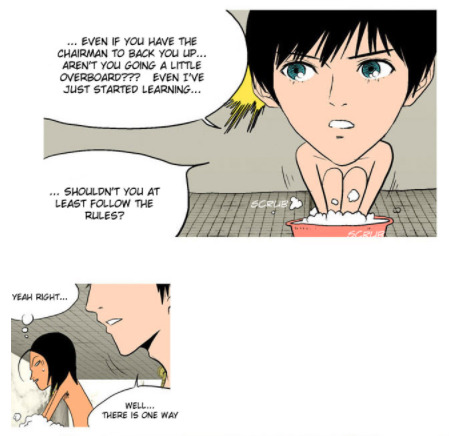#like i have said a million times it feels more appreciative to respond individually vs posting one big post while not responding to anyone
Explore tagged Tumblr posts
Note
"Why are you posting all the happy birthdays" anon you sound like a kill joy. Anyways happy birthday!!!!
🥳🎊🎉🥳🎊🎉🥳🎊🎉🥳🎊🎉🥳🎊🎉🥳🎊🎉
thank u!! and i appreciate the reassurance 🩵🩵
#it’s made me even more worried ab posting them but i’ll continue to respond to different anon messages & people not on anon#like i have said a million times it feels more appreciative to respond individually vs posting one big post while not responding to anyone#idk maybe i’m wrong for that#im so sorry to everyone who was super annoyed all day today#sorry to everyone who hates me now and also to everyone who unfollowed (birthday posts are the last straw i guess)#i love everyone who took the time to send me a message i adore u thank u
5 notes
·
View notes
Text
The God of Bath Review
This review, by current standards at least, could be considered a “Quality Drop”, but i still wanted to post it anyway.
With that said, I hope you like the review!:
.
.
.
.
Intro Sequence
It’s official description reads:
“Heo Sae, wants to be the best person in spa massage and scrub, has battles with others.”
And if you want to suck out all the nuance, then that is the simple premise on which all 30 episodes of this manhwa are built on but let’s spruce this up a bit
“God of Bath” follows Heo Sae, a narcissistic jobless college grad that’s found himself indebted to a loan shark because he keeps trying to chase the chic city life of Seoul, South Korea. After being bailed out of his debt by the Chairman of ‘Geumja Public Bath’ because he has the hands of Taemirus also known as the God of Bath. Heo must work off his debt by participating in the ‘Bath Star M’ contest, the winner will be crowned the best “Ttaemiri”, given 300 million won in prize money and a luxury Sedan
Side note: Ttaemiri - a professional scrubber who scrubs down in bathers in a public bathhouse
Setting:
The primary location of ‘God of Bath’ is the ‘Geumja Public Bath’. A giant Pyramid in the middle of a town, also I know I’m colourblind but is it just me or does the colour look oddly like...hmmm(*sound of running water*).
The comic skews heavily in using 3D renders coupled with some drawn over assets and while these shots aren’t my favourite they’re hardly the point. Most of the art in God of Bath seems to serve the purpose of giving you an appreciation of the world Heo Sae envies and wishes deeply to be a part of. It sets the stakes for what he stands to lose if he loses the Bath Star M contest. Thus = This could be due the fact that regardless of which type of comedy I categorized this webtoon as, it’s still a comedy, and I didn’t start reading so I could find exceptional art, but the poor 3d models somehow compliments the art that is actually drawn. Maybe its the simplistic art and lack of drawn detail. Whatever it is, it works.
Characters:
God of bath is home to a cavalcade of characters.
First there’s Heo Sae - The Humbled Narcissist:

( ^ Chapter 1)
He is a narcissistic college grad, who in the 8th grade decided to move to Seoul Korea to put distance between himself and inheriting his late father's bath business. He is a trend chaser and deeply cares about keeping up appearances. Despite giving off an egotistical demeanor, he is still a respectful person.
Then we have Kang Hae - A Traditional Professional:

( ^ Chapter 3 )
Kang Hae is a traditional Ttaemiri, who is diligent and is strict about safety. Kang Hae is introduced as Hae’s ideal endpoint if he devotes himself to “Tae” the art of scrubbing. He is an earnest individual with no sympathy for those that look down on Ttaemiri, or the dreams of others. It’s revealed during the second round of the ‘Bath Star M’ contest that the chairman had to retire after hurting his right arm protecting Kang. An example of this would be when he responds to Hae downplaying the skills of Ttaemiri in an attempt to not look as shameful about his loss in the Bath Combat (Chapter 4)
And then theirs his Kanh hae’s Rival, Kim Seonggong - The Icarus of Ttaemiri

( ^ Chapter 16′s Beginning Art )
Is an Elite Ttaemiri, whom unlike Kang Hae, seemed to have grown up under normal circumstances, but chose to become a Ttaemiri regardless. During a bath seminar, he debuts a “bath paddle”, which is a curvy white knife, to scrub off the dead skin of a homeless man. After the demonstration, Kang asks Seong why he is so eager to succeed. Kim responds in kind, “People tend to reach higher places… Should there be a reason for that?” Because of his desire to succeed, he can be seen as an opportunist. As he will tend to as many VIP’s as possible, postponing the regulars he would usually scrub.
Immersion:
Now, right off the bat, It may seem weird to be discussing Immersion in relation to the comedy genre on webtoon, but hear me out:
Generally there are two ways comedy is portrayed in webcomics,
Stories where consequences are never/very occasionally carried over into the following episodes, think Garfield
Stories where consequences are carried over and the character roster is unchanging, think
‘God of Bath’ falls under the latter, meaning that although its jokes are a major selling point of the webcomic itself, it still has an ongoing plot that you can attach yourself to and enjoy. Although I have read webtoons like ‘God of Bath’, I found myself forgetting that it was mainly categorized as a comedy. This isn’t to say that it isn’t funny, but the webtoon treats the plot as important as the humour it presents.
2. Execution (Is it funny?):
When thinking about the execution of ‘God of Bath’, we’d naturally have to think about 3 things. The jokes considering that it's under “Comedy”, the “Arc” that Heo Sae goes through, and the logistics of anything “bath” related that this webcomic is asking you to accept (which I will explain why it is important to any degree in a bit).
But first, the funny ha ha moments. Naturally, no matter how objective I want to be about this section. Whether or not this webtoon is funny is completely up to YOU, the reader. That being said, throughout the time I was reading these 30 episodes, I found myself often smiling. Referring back to the art, the way Creator Ilkwon draws Heo Sea is unique enough to the point where I can’t help my face just lock into a grin.
Moving on to Heo’s unintentional journey towards bettering himself, “God of Bath” is surprisingly realistic with the way certain situations unfold in the story, despite it being a comedy. In the span of 30 episodes, Heo is somehow completely unrecognizable when compared to his chapter 1 counterpart. Honestly, there is way more nuance in this webcomic than it really should have. I say it like it's a negative, but it's honestly just unexpected. Especially since the webcomic doesn’t wear a message on it’s sleeve.
Finally, the logistics of anything bath related. If I’m going to be honest, if God of Bath’s “logic”, wherever there is, when it comes to scrubbing was 100% false, I wouldn’t really bat an eye to it. Because scrubbing is more of a device used to progress the plot rather than as a selling point for the story. Which is weird considering that all bath related activities is what makes God of Bath, ‘God of Bath’. The fact that Geumja public bath is able to disguise itself as the centerpiece of the webcomic instead of Heo’s arc in the comic, all the while both being enjoyable to read regardless, makes the Webtoon succeed, and properly deserve being among the list of Originals on the site.
3. Style:
I already touched upon the quality of the webtoons setting, so the main focus will go towards the art of the cast themselves and how it translates towards telling the story.
‘God of Bath’’s art can be summarized through this one panel of Heo Sea (Chapter 3):

Although Ilkwon Ha has a decent grasp on how to draw his characters, it never stops him from drawing absurd versions of the cast. But more importantly than that, he doesn’t always stay consistent with the way he draws gags. There are multiple combinations or versions of some gags that it never really feels repetitive.
An example of this would be of when Heo Sae takes a selfie.
Chapter 1

Vs.
Chapter 8

There are countless amounts of this specific panel sprinkled throughout the 30 episodes, but I can’t help but crack a smile seeing it regardless.
Here are some more examples of Ilkwon Ha blurring the line between a gag drawing and a normal panel.
( Both of these panels come from Chapter 6 )


Gag panels aside, I have come to like Ilkwon Ha’s intro panels. Seeing them somehow feels refreshing every time I read a new chapter. I think it’s because the art is usually ‘peaceful’ or ‘calm’, which you could even say matches how customers feel after being scrubbed down by the Ttaemiri in Geumja. I don’t know, that's just me spitballing.
(All 3 of these images come from Chapter 1)



Originial Opinion: (If you want to elaborate on how 3D models are used throughout the webcomic, go for it. I don’t really have much opinion on it besides the fact that- it exists).
In Retrospect: I was going to leave tis review untouched for when I posted it since I did this a while back and it shows a good sense of progress for me personally, but I just wanted to say that the 3D models kinda grew on me, and somehow contribute to the Webcomics style despite being so clearly out of place.
Conclusion:
Overall, after reading ‘God of Bath’, it could have truly succeeded as an episodic series. The story concept alone gives it enough creative freedom in expanding the “Bath World”.
But most important of all fleshing out the characters more.
At the very least, seeing how Seonggongs’s path towards greatness would have unfolded. Because no matter how much I dwell on his character, it feels like his arc as a character was incomplete. Or rather, it feels like there was missed potential.
THAT BEING SAID, the webcomic itself was very complete, seeing as how it was about Heo Sae’s values and how those values change throughout the comic.
I should also note that APPARENTLY, there was going to be a movie adaptation released in 2015, but due to the main lead (Kim Young-Kwang) finding a successful role in “Pinocchio”, it got shafted. Which sucks because while I was writing this I was thinking about how this should get an animated adaptation like ‘Tower of God’.
All in all, I definitely suggest you give ‘God of Bath’ a chance, because it just may surprise you how, before you know it, the webcomic is already pulling you into its odd, yet realistic world.
#Naver#Naver Webtoon#Webtoon#Webtoons#Webcomic#Webcomics#God of Bath#GodofBath#Webcomic Review#Webtoon Review#Naver Webtoon Review
0 notes
Text
Top 5 Marketing Attribution Trends for 2019
Marketers are struggling with the lack of data to optimize their spending to revenue, yet CMOs are under increasing pressure to “show the money” and deliver on revenue expectations. Here’s President and Founder of DemandIT, Yancy Oshita’s take on what this means for marketing attribution in 2019.
According to the Gartner CMO Spend Survey 2017-2018, senior marketing leaders must consistently show solid return on investment. Increasingly, budgets are being conditioned with weighty expectations for future business performance and are being compared to industry benchmarks. Candidly, I didn’t fully appreciate this trend (or the challenges associated with this level of accountability) until my CMO assignments with venture-based tech companies. While 82% of CMOs report that their goals are aligned to revenue targets (Forrester Research), marketers are struggling with lack of insight to continuously optimize their spending and demonstrate a high return on marketing to their investors. The time has come for marketing to show “show the money,” proving it can deal with financial constraints and deliver on revenue goals. Here’s my take on what this means for marketing attribution in 2019:
Connecting Marketing to Revenue Outcomes
Having been responsible for marketing governance at board meetings, I made it a point as a CMO to educate myself on measurements like customer lifetime value (CLTV), customer acquisition cost (CAC), “magic number,” return on marketing investment (ROMI), and other board-level indicators. During my stints I learned firsthand that investors view modern marketing as an increasingly bigger driver of revenue growth. While they appreciate traditional updates on branding efforts and traffic growth, board members are most interested in the contribution to revenue and return on marketing. In effect:
What was the actual spend and revenue outcome this quarter? Compared to target?
How are we trending in marketing efficiency (revenue/cost, CAC)? Compared to industry?
And for both the above, “why?”, “what led to revenue?”, “what do we need to stop? and so on
Also Read: 5 Performance Marketing Basics in an Omni-Channel World
For 2019: Business (and investor) demand to connect marketing to revenue outcomes will accelerate. Tracking your spending across virtually every area of marketing and determining its contribution to revenue will become a marketing imperative. This includes having the marketing attribution telemetry to drill down, analyze and rebalance any program, campaign, touchpoint, and/or channel that can improve or degrade revenue performance, including end-to-end visibility of how buyers are interacting with your brand through their entire purchase path. As an aside, this is where multi-touch attribution technology has a huge advantage for marketers. While CRM, web analytics and other traditional marketing technologies track ROI within their respective silos, advanced multi-touch attribution technology sees how your programs are contributing to revenue from start to finish of your buyer’s journey.
Rise of Multi-Touch Attribution
Marketing attribution is as old as the first digital ads in mid-nineties with “click-through rates” to measure impact and later expanding with modern CRM, web analytics, ecommerce and marketing automation tools adding things like “leads created” and “sales converted.” Being able to measure the performance vs the cost (CPM) of different programs such as Google Ads or sponsored content was the beginning of marketing’s transformation from a “cost center” managing budgets to a “revenue driver” delivering outcomes. Let’s look at the implications the implications of this in today’s viciously competitive digital world with empowered buyers, complex journeys, and an explosion in digital technologies, creating dozens (perhaps hundreds in the case of major brands) of disconnected one-touch “conversions” all claiming to deliver the highest ROI. When I was marketing in the late nineties, marketing attribution was managed by using proxies and massaging spreadsheets. It kinda worked. However, stitching together first-touch or last-touch approaches is simply untenable in today’s hyper-complex, data-driven environment – you simply can’t “see the forest for the trees” and are forced to use various proxies to determine impact to revenue, essentially guessing your way to optimizing your spend.
Simple one-touch, last-touch or first-touch marketing attribution will to be used for specific departmental purposes in 2019, but multi-touch attribution will become a marketing imperative – and the interest in multi-touch attribution is gaining momentum according to a 2017 research study by the Marketing Attribution Think Tank that showed “75% of respondent marketers said they are or will be using multi-touch attribution within 18 months.” In lay terms, advanced marketing (multi-touch) attribution is the science of quantifying the relative impact your marketing touches have on revenue. The term “relative” is critical because it means your individual touches such as a retargeting ad or email offer are always being compared to others in terms of their impact on revenue. While there are different multi-touch attribution models such as position-based and W-model, all of them allow marketers to see a full buyer conversion path from start to finish including on and offline interactions, as well as through various devices such as your phone or laptop. Most advanced multi-touch attribution systems automatically connect and assign (and allow you to refine) the revenue and associated cost of every touch (onmichannel) across your buyers journey. With this level of insight into what’s really influencing (or not) your buyer’s journey, you can make more precise decisions to continuously rebalance your marketing spend to maximize revenue.
Performance Monitoring of Ad Vendors Comes of Age
The rising expectation for marketing to grow revenue is bringing a torrent of third-party digital advertising opportunities. To be specific, digital or online ad spending hit $209 billion in 2017, eclipsing traditional TV for the first time with an endless array of paid options promising to “grow your traffic,” “give you leads,” and “meet your business goals.” If every commitment from every advertiser was met, why are most marketers still struggling? The changing nature of marketing attribution is less about the “bells and whistles” of specific ad platforms and more about governing their performance in the context of true revenue contribution. For example, when you’re spending millions in ads through Google, AdRoll, and others, do you have the marketing attribution telemetry to accurately determine and compare their cost and contribution to revenue? How do you attribute ROI involving multiple ad touches associated with a sale and/or longer buying journeys? Can you promptly alert and stop the poor performers and rebalance to higher performers?
A breach (yes, marketers need to start thinking in terms like this) in online ad performance expectations results in lost revenue that can easily reach into the millions. For 2019, demand to implement advanced multi-touch attribution to accurately track, compare, and manage ad vendors will rise. Marketers will continue to instrument their multi-touch attribution systems with effective ad ROI methods such as automated cohort analysis to allow them to know the true ROI (revenue contribution, cost) and compare apples to apples between different programs. For example, let’s say you spend $50,000 each with Google Ads and Adroll on June 1 and want to know how well the campaign has performed through September 30; a multi-touch attribution system using a cohort method would automatically track their respective touches and, in sales conversions where both have touched the buyer, allocate a portion of the revenue credit not to exceed 100%. This eliminates fuzzy math and duplicate credit and gives you true insight as to what’s really converting (and not) with your ad vendors. But it is only the first step to tackling modern online ad management. Marketers also will build the requisite skills and processes to set performance level objectives (PLOs) with ad vendors and hold them accountable when they breach your ROI expectations.
Shift to a Marketing Attribution System of Record
Consider this scenario: Your team keeps missing revenue and efficiency goals. In their zeal to improve customer acquisition using the same dollars, they spend countless days extracting data from your website, CRM and a multitude of other systems, meeting with advertisers, and iterating numerous spreadsheets to discover the root cause(s) and fined the “silver bullet.” With pressure mounting, “experts” are called in to perform a thorough media mix model or full waterfall examination, reviewing marketing attribution data from various sources and coming up with high-level (often templated) guidance on where to spend marketing dollars. In meantime, money is being wasted on doing the same things over and over again with little to show. When it comes to attribution insight to do their jobs, most marketers feel they are in a constant state of “data chaos,” suffocating under a combination of web, channel and CRM data that have been stitched together with Excel. And how actionable, timely, and trusted are the findings?
The adoption of a marketing attribution system of record will swell in 2019 as digital and offline marketing channels grow and “data chaos” becomes unbearable in terms cost, scalability and data fidelity. Modern multi-touch attribution platforms capture date directly from your ad and conversion (CRM, ecommerce, web, etc) sources. They also collect buyer interactions outside of ad and conversion databases via UTM parameters, click redirects and other unique identifiers. A marketing attribution system of record allows you to precisely and efficiently allocate revenue and cost to your marketing touches and channels that contributed to a sale. Aiming for a multi-touch attribution system to this standard means you’ll have the attribution foundation or “plumbing” in place that frees marketers from “data jail” to focus their energy on optimizing marketing spend to revenue.
Emerging Marketing Organizations and KPIs
Marketing organizations and KPIs are predicated on the technology at a given time. As adtech and martech evolved, we saw organization models change around these newer capabilities in order to maximize the results they pledged. Today it’s common to see organizations designed around domains like channels like paid media types and vendors, owned media such as website, blogs and emails, and other variations. While this approach by itself is useful for activities like ad effectiveness, A/B testing, and in-channel optimization, it’s inadequate to optimize marketing spend to revenue. While the Bing Ads media manager is guarding his budget and driving click-throughs, the offline (i.e., events, direct mail) marketing manager is watching her budget and delivering leads, and the SEO marketing manager is generating traffic. But does anyone know how there touches contribute to revenue?
Also Read: Data Visualization: What Is it? Why Does it Matter in Marketing?
In 2019 we’ll see more companies tune their organization models around the intelligence provided by advanced multi-touch attribution technology to optimize revenue outcomes. We will see a rise in organization concepts around customer segments or buyer types, where they use “prescriptions” from multi-touch attribution models to systematically optimize spend across various channels from initial to last touch. At the same time, channel and other traditional marketing functions will likely evolve from departmental KPIs to more customer-centric outcomes such as incremental revenue, new customers, customer lifetime value and acquisition cost. Multi-touch attribution technology is bringing the science of marketing to a whole new level and organizations need to evolve with it to reap the enormous efficiency gains found in marketing analytics and attribution data.
This article was first appeared on MarTech Advisor
0 notes